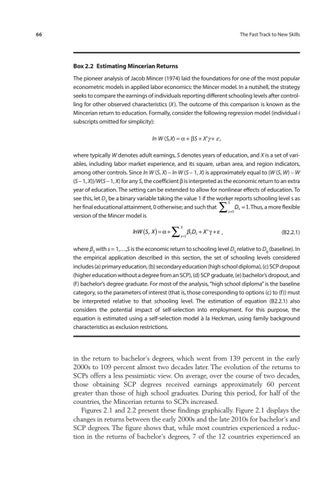66
The Fast Track to New Skills
Box 2.2 Estimating Mincerian Returns The pioneer analysis of Jacob Mincer (1974) laid the foundations for one of the most popular econometric models in applied labor economics: the Mincer model. In a nutshell, the strategy seeks to compare the earnings of individuals reporting different schooling levels after controlling for other observed characteristics (X ). The outcome of this comparison is known as the Mincerian return to education. Formally, consider the following regression model (individual i subscripts omitted for simplicity): ln W (S,X) = α + βS + X’g + e , where typically W denotes adult earnings, S denotes years of education, and X is a set of variables, including labor market experience, and its square, urban area, and region indicators, among other controls. Since ln W (S, X) – ln W (S – 1, X) is approximately equal to (W (S, W) – W (S – 1, X))/W(S – 1, X) for any S, the coefficient β is interpreted as the economic return to an extra year of education. The setting can be extended to allow for nonlinear effects of education. To see this, let DS be a binary variable taking the value 1 if the worker reports schooling level s as S her final educational attainment, 0 otherwise; and such that Ds = 1. Thus, a more flexible s =0 version of the Mincer model is
∑
lnW (S , X ) = α +
∑
S s =1
β s Ds + X ' γ + ε , (B2.2.1)
where βS with s = 1,…,S is the economic return to schooling level DS relative to D0 (baseline). In the empirical application described in this section, the set of schooling levels considered includes (a) primary education, (b) secondary education (high school diploma), (c) SCP d ropout (higher education without a degree from an SCP), (d) SCP graduate, (e) bachelor’s dropout, and (f) bachelor’s degree graduate. For most of the analysis, “high school diploma” is the baseline category, so the parameters of interest (that is, those corresponding to options (c) to (f)) must be interpreted relative to that schooling level. The estimation of equation (B2.2.1) also considers the potential impact of self-selection into employment. For this purpose, the equation is estimated using a self-selection model à la Heckman, using family background characteristics as exclusion restrictions.
in the return to bachelor’s degrees, which went from 139 percent in the early 2000s to 109 percent almost two decades later. The evolution of the returns to SCPs offers a less pessimistic view. On average, over the course of two decades, those obtaining SCP degrees received earnings approximately 60 percent greater than those of high school graduates. During this period, for half of the countries, the Mincerian returns to SCPs increased. Figures 2.1 and 2.2 present these findings graphically. Figure 2.1 displays the changes in returns between the early 2000s and the late 2010s for bachelor’s and SCP degrees. The figure shows that, while most countries experienced a reduction in the returns of bachelor’s degrees, 7 of the 12 countries experienced an

